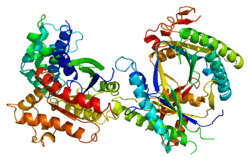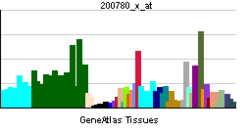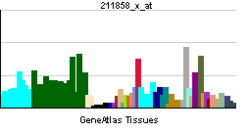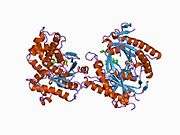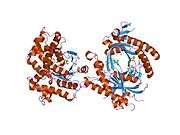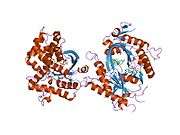GNAS complex locus
| View/Edit Human | View/Edit Mouse |
GNAS complex locus, also known as GNAS, is a protein which in humans is encoded by the GNAS gene. The protein encoded by this gene is the stimulatory G-protein alpha subunit (Gs-α), a key component of many signal transduction pathways.
Gene
This gene locus has a highly complex imprinted expression pattern. It gives rise to maternally, paternally, and biallelically expressed transcripts that are derived from four alternative promoters and 5' exons. Some transcripts contains a differentially methylated region (DMR) at their 5' exons, and this DMR is commonly found in imprinted genes and correlates with transcript expression. An antisense transcript exists, and this antisense transcript and one of the transcripts are paternally expressed, produce noncoding RNAs, and may regulate imprinting in this region. In addition, one of the transcripts contains a second overlapping open reading frame, which encodes a structurally unrelated protein, called ALEX.[3][4]
The GNAS locus is imprinted and encodes 5 main transcripts:
- Gs-α
- XLAS
- NESP55
- A/B transcript
- antisense GNAS transcript
Protein
Alternative splicing of downstream exons is also observed, which results in different forms of the stimulatory G-protein alpha subunit (Gs-α), a key element of the classical signal transduction pathway linking receptor-ligand interactions with the activation of adenylyl cyclase and a variety of cellular responses. Multiple transcript variants have been found for this gene, but the full-length nature and/or biological validity of some variants have not been determined.
Clinical significance
Mutations are associated with:
- Albright hereditary osteodystrophy
- pseudohypoparathyroidism type Ia
- pseudohypoparathyroidism type Ib
- pseudopseudohypoparathyroidism
- McCune-Albright syndrome
Mutations in this gene also result in progressive osseus heteroplasia, polyostotic fibrous dysplasia of bone, and some pituitary tumors.[5]
Interactions
GNAS complex locus has been shown to interact with RIC8A.[6]
References
- ↑ "Human PubMed Reference:".
- ↑ "Mouse PubMed Reference:".
- ↑ Klemke M, Kehlenbach RH, Huttner WB (July 2001). "Two overlapping reading frames in a single exon encode interacting proteins--a novel way of gene usage". The EMBO Journal. 20 (14): 3849–60. doi:10.1093/emboj/20.14.3849. PMC 125537
 . PMID 11447126.
. PMID 11447126. - ↑ Abramowitz J, Grenet D, Birnbaumer M, Torres HN, Birnbaumer L (June 2004). "XLalphas, the extra-long form of the alpha-subunit of the Gs G protein, is significantly longer than suspected, and so is its companion Alex". Proceedings of the National Academy of Sciences of the United States of America. 101 (22): 8366–71. doi:10.1073/pnas.0308758101. PMC 420400
 . PMID 15148396.
. PMID 15148396. - ↑ "Entrez Gene: GNAS GNAS complex locus".
- ↑ Klattenhoff C, Montecino M, Soto X, Guzmán L, Romo X, García MA, Mellstrom B, Naranjo JR, Hinrichs MV, Olate J (May 2003). "Human brain synembryn interacts with Gsalpha and Gqalpha and is translocated to the plasma membrane in response to isoproterenol and carbachol". Journal of Cellular Physiology. 195 (2): 151–7. doi:10.1002/jcp.10300. PMID 12652642.
Further reading
- Tinschert S, Gerl H, Gewies A, Jung HP, Nürnberg P (March 1999). "McCune-Albright syndrome: clinical and molecular evidence of mosaicism in an unusual giant patient". American Journal of Medical Genetics. 83 (2): 100–8. doi:10.1002/(SICI)1096-8628(19990312)83:2<100::AID-AJMG5>3.0.CO;2-K. PMID 10190480.
- Faivre L, Nivelon-Chevallier A, Kottler ML, Robinet C, Khau Van Kien P, Lorcerie B, Munnich A, Maroteaux P, Cormier-Daire V, LeMerrer M (March 2001). "Mazabraud syndrome in two patients: clinical overlap with McCune-Albright syndrome". American Journal of Medical Genetics. 99 (2): 132–6. doi:10.1002/1096-8628(2000)9999:999<00::AID-AJMG1135>3.0.CO;2-A. PMID 11241472.
- Raymond JR, Mukhin YV, Gelasco A, Turner J, Collinsworth G, Gettys TW, Grewal JS, Garnovskaya MN (2002). "Multiplicity of mechanisms of serotonin receptor signal transduction". Pharmacology & Therapeutics. 92 (2-3): 179–212. doi:10.1016/S0163-7258(01)00169-3. PMID 11916537.
- Weinstein LS, Chen M, Liu J (June 2002). "Gs(alpha) mutations and imprinting defects in human disease". Annals of the New York Academy of Sciences. 968: 173–97. doi:10.1111/j.1749-6632.2002.tb04335.x. PMID 12119276.
- Bastepe M, Jüppner H (2005). "GNAS locus and pseudohypoparathyroidism". Hormone Research. 63 (2): 65–74. doi:10.1159/000083895. PMID 15711092.
- de Sanctis L, Delmastro L, Russo MC, Matarazzo P, Lala R, de Sanctis C (May 2006). "Genetics of McCune-Albright syndrome". Journal of Pediatric Endocrinology & Metabolism. 19 Suppl 2: 577–82. PMID 16789620.
- Aldred MA (May 2006). "Genetics of pseudohypoparathyroidism types Ia and Ic". Journal of Pediatric Endocrinology & Metabolism. 19 Suppl 2: 635–40. PMID 16789628.
- Jüppner H, Bastepe M (May 2006). "Different mutations within or upstream of the GNAS locus cause distinct forms of pseudohypoparathyroidism". Journal of Pediatric Endocrinology & Metabolism. 19 Suppl 2: 641–6. PMID 16789629.
- Mantovani G, Spada A (December 2006). "Mutations in the Gs alpha gene causing hormone resistance". Best Practice & Research. Clinical Endocrinology & Metabolism. 20 (4): 501–13. doi:10.1016/j.beem.2006.09.001. PMID 17161328.
External links
- GNAS protein, human at the US National Library of Medicine Medical Subject Headings (MeSH)
